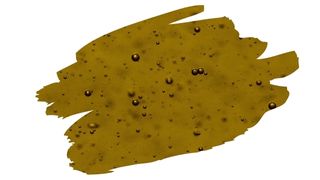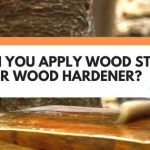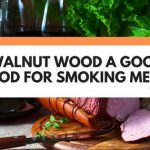Bubbles in wood finishes is one of the most frequent questions we get emailed about here at The Woodwork Place.
And it is a wood finishing problem that crops up every so often, regardless of what type of oil-based finish you’re using.
From varnishes to polyurethane to oil finishes, air bubbles can sometimes get caught in a finish thats dried too fast.
So, what can you do to prevent air bubbles from forming inside your Waterlox wood finish? And what’s causing them to appear in the first place?
Well, in this post you will learn why sometimes tiny air bubbles can tend to form in oil-based wood finishes. You will also learn a little bit about a wood finishing technique called ‘tipping off’ — and how it can help get rid of those troublesome bubbles.
And keep reading to discover three simple things you can do to get a bubble-free Waterlox finish.

This post may contain affiliate links to products that we receive a commission for (at no additional cost to you). Learn more here.
What Is Waterlox? Is It Basically Just Tung Oil?
Waterlox is a fantastic matte-looking wood finish that contains natural Tung oil.
However, the traditional Waterlox wood finish, is more of a Teak oil or varnish. That’s because this penetrating oil-based wood finish contains — along with Tung oil — Linseed oil, phenolic resins, and mineral spirits.
Related Post: Will Applying Tung Oil On Exterior Pressure Treated Wood Protect It?
Got It. So Whats Causing All Of Those Bubbles In Waterlox?
Quick answer? Chemical Reactions.
You see, when a wood finish cures, it is in fact going through a chemical reaction. This is opposed to when they simply dry, (a completely separate process), which is a case of evaporation.
Now, drying (evaporation) turns Waterlox from a liquid into a film. Yet it is the curing process (chemical reaction) that turns this wood finish into a hard resinous substance.
But, here’s the thing; chemical reactions generate a fair amount of heat. So much so, that the heat produced will warm up anything else nearby.
So Chemical Reactions Cause Heat. Tell Me, Why Does This Matter Again?
Well, the heat generated will evaporate some of the moisture content naturally stored inside wood fibers. And when moisture evaporates — but is trapped in the still-curing liquid beneath a dry wood finish film — it can form air bubbles.
Generally, this is not a problem in and of itself. Air bubbles will rise, pop — and ultimately escape from a wood finish — all on their own.
However, in order for this to happen, we need wood finishes to dry fairly slowly. If Waterlox dries too quickly, those rising bubbles will not have time to escape.
This is why we sometimes add slow-speed thinners to certain wood finishes, (such as polyurethane), to help slow down drying.
Is Trapped Air (From Inside Wood) The Only Reason Why It’s Bubbling Up?
Not always. Another cause for bubbles can stem from improper brush preparation.
You always need to prep a brush before you apply any wood finish. And you do this by dipping it in a solvent first, before you go dipping it into that Waterlox can.
OK. And How Do You Get A Smooth Waterlox Finish?
Well, the best way to avoid air bubbles is by following these best application practices:
1). Stir (Never Shake)
If that Waterlox finish has settled in the can, then stir it around. Never shake the can.
2). Rinse The Brush Beforehand
Dip the brush in solvents, such as mineral spirits, before you dip it into this oil-based wood finish.
3). Apply Thin Coats
Try to apply thin coats. Avoid thickly coating on this finish, and wipe away any excess as best you can.
Got It…But How Do You Get Bubbles Out Of This Wood Finish While It’s Still Wet?
You can try a wood finishing technique known as ‘tipping off’.
When you tip-off a wood finish you are simply using your brush to ‘press’ those bubbles out. This requires a light touch though, as it involves sweeping the very tip of the brush bristles along with the grain.
Having said that, tipping-off is a bit of a coin-flip as to how effective it is at getting rid of bubbles (especially on thickly coated wood finishes).
Nevertheless, if you follow a couple of key steps, tipping off should be enough to get rid of the bubbles:
Step 1). Always Use A Clean Bristle Brush
The brush you use to tip off Waterlox finishes should be clean.
On top of that, bristle brushes (particularly natural bristle brushes), can have little pockets of air in their bristles. And if you’re not careful, that brush could add more bubbles to your finish, rather than smooth them away.
So, make sure you dip the brush in mineral spirits first, (and then squeeze away any excess), before you begin.
Step 2). Keep The Pressure Very Light
You need to keep things light as you move the brush with the grain. There should be very little downward pressure at all.
In fact, if the bristles of the brush begin to bend, then that’s a sign that you’re pressing down a touch too hard.
But The Finish Already Has Bubbles On It. How Do You Get Bubbles Out Of A Dried Wood Finish?
At this point, your last-gasp option is to sand away the sections that contain those bubbles, and then reapply:
1). First off, wait for that Waterlox coat to dry and harden. You may need to wait for it to wholly cure too.
2). Afterward, grab some 80-grit sandpaper and begin sanding away the bubbled sections.
3). Once those bubbles are gone, you can now use 100-grit to 120-grit sandpaper to even out the surface once again.
4). Last, but not least, you can go ahead and apply a top coat of Waterlox.
To Wrap Up, Here Are The 3 Key Takeaways From This Post…
- 1). Waterlox is a Tung oil based wood finish.
- 2). If Waterlox dries too fast, this may end up causing air bubbles to become trapped in this otherwise smooth matte wood finish.
- 3). You can remove bubbles from still-wet wood finishes by ‘tipping off’ the finish. You do this by lightly sweeping the finish with the tip of a bristle brush.
References:
Arminger, Benjamin, et al. “On the drying behavior of natural oils used for solid wood finishing.” Progress in Organic Coatings 148 (2020): 105831.



